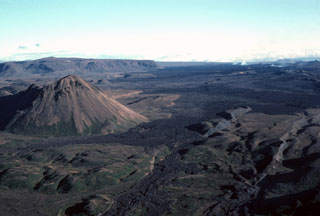Report on Krafla (Iceland) — September 1977
Natural Science Event Bulletin, vol. 2, no. 9 (September 1977)
Managing Editor: David Squires.
Krafla (Iceland) Deflation accompanied by a basaltic eruption and fault movements
Please cite this report as:
Global Volcanism Program, 1977. Report on Krafla (Iceland) (Squires, D., ed.). Natural Science Event Bulletin, 2:9. Smithsonian Institution. https://doi.org/10.5479/si.GVP.NSEB197709-373080
Krafla
Iceland
65.715°N, 16.728°W; summit elev. 800 m
All times are local (unless otherwise noted)
Krafla caldera deflated on 8 September, accompanied by a short basaltic eruption and large scale movement on faults S of the caldera. Since the 27 April deflation (2:4) the center of the caldera had inflated about 6-7 mm/day, and by 8 September had returned to approximately the pre-27 April elevation. An increase in the number of earthquakes within the caldera, which had preceded earlier deflation events, did not occur prior to the 8 September deflation.
Chronology of [8 September 1977] events. 1547: First appearance on seismographs of continuous harmonic tremor, coinciding with the beginning of deflation.
1800: Effusive eruption began from a 900-m fissure N of the caldera rim, just N of the 27 April eruption site. By just after 2000, lava flows had reached their maximum extent, covering about 0.8 km2. The eruption had ceased by [2230].
[2240]: Beginning of movement on faults in the Námafjall area, S of the caldera and about 14 km from the eruption site. The earthquakes were centered 3-4 km closer to the caldera than during the 27 April event, but many of the same faults were active. A few cubic meters of extremely glassy vesicular scoria were erupted from an 1,134-m drillhole in the Námafjall area during the earthquake swarm.
After two days of deflation, inflation of the caldera resumed and was continuing in late September at the pre-deflation rate. The fault zone in the Námafjall area has widened more than 1 m since August. Old thermal fields show increased activity and new fields have developed. Parts of the diatomite factory near Námafjall were severely damaged and some of the steam drillholes were seriously affected, but there were no accidents or injuries.
Further References. Brandsdottir, B., and Einarsson, P., 1979, Seismic activity associated with the September 1977 deflation of the Krafla central volcano in northeastern Iceland: JVGR, v. 6, p. 197-212.
Larsen, G., Grönvold, K., and Thorarinsson, S., 1979, Volcanic eruption through a geothermal borehole at Námafjall, Iceland: Nature, v. 278, p. 707-710.
Geological Summary. The Krafla volcanic system in the Northern Volcanic Zone (NVZ) of Iceland is about 100 km long, consisting of a fissure swarm and a central volcano with a 7 x 9 km caldera formed about 110,000 years ago that deposited a rhyolitic welded tuff. It has been moderately active in the Holocene, over three distinct eruptive periods; the current one has lasted about 2,800 years with six volcano-tectonic episodes, each with one or more basaltic fissure eruptions. Lava volumes (DRE) have been in the 0.1-1 km3 range. The Hverfjall and Ludent tuff rings east of Myvatn were erupted along the fissure system. Myvatn lake formed during the eruption of the older Laxarhraun lava flow from the Ketildyngja shield volcano of the Fremrinamur volcanic system about 3,800 years before present (BP); The present Myvatn lake is constrained by the roughly 2,000 years BP younger Laxarhraun lava flow from the Krafla volcanic system. The abundant pseudocraters that form a prominent part of the Myvatn landscape were created when the younger Laxarhraun lava flow entered the lake. The last eruption took place in 1975-1984 CE when nine small basaltic fissure eruptions produced 0.25 km3 of lava.
Information Contacts: G. Sigvaldason, NVI.

